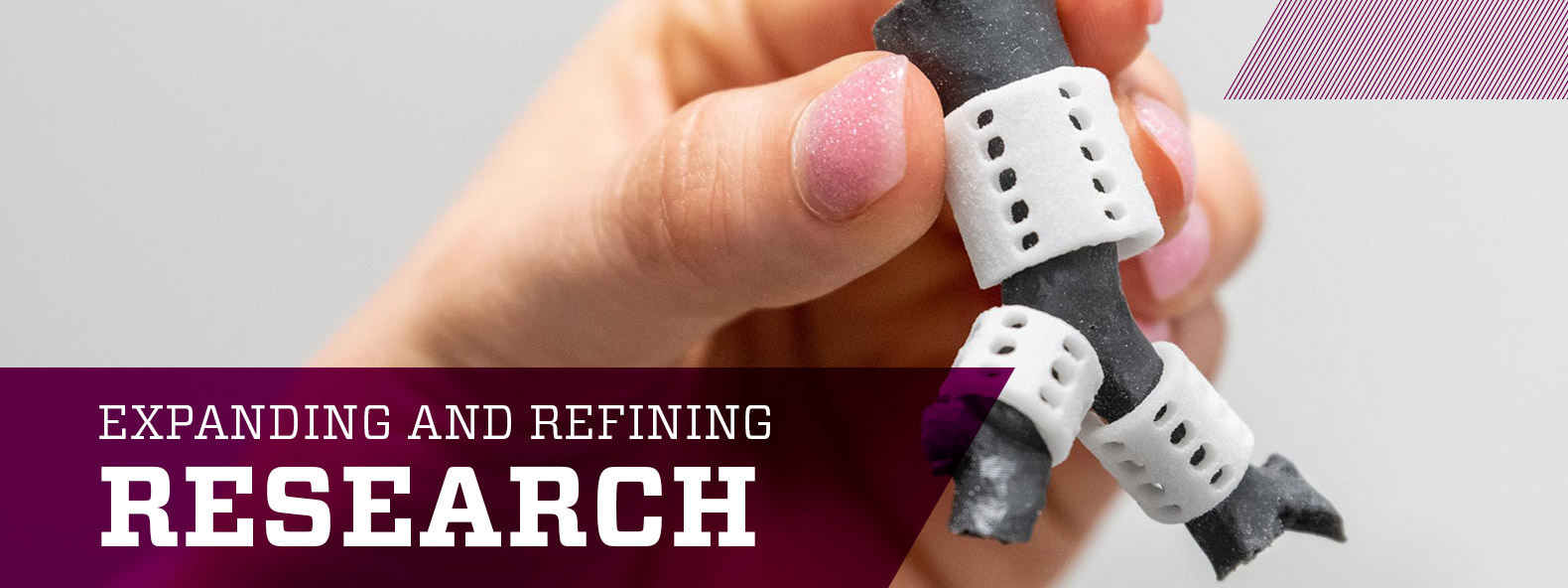
Annual Report 2019: Expanding and Refining Research
Tech’s research enterprise continues to enjoy tremendous growth, with total research expenditures and other sponsored activities increasing from $908 million in FY 18 to nearly $978 million in FY 19. Structural changes have been implemented to ensure that the Institute can keep pace with this promising expansion and efficiently continue producing the results that make Georgia Tech one of the world’s leading research universities.
Tech's Biomedical Engineers Enable Groundbreaking Pediatric Surgery
With assistance from Georgia Tech, Children’s Healthcare of Atlanta has performed Georgia’s first-ever procedure to place 3D-printed tracheal splints in a pediatric patient. The splints were designed by Scott Hollister, who holds the Patsy and Alan Dorris Endowed Chair in Pediatric Technology, a joint initiative supported by Georgia Tech and Children's Healthcare of Atlanta. (Credit: Children's Healthcare of Atlanta)
Tech’s Biomedical Engineers Enable Groundbreaking Pediatric Surgery
In fall 2018, Children’s Healthcare of Atlanta performed Georgia’s very first procedure to place 3D-printed tracheal splints in a pediatric patient. A cross-functional team of Children’s surgeons used three custom-made splints, which Georgia Tech’s biomedical engineers helped create using experimental 3D-printing technology, to assist the breathing of a 7-month-old patient battling life-threatening airway obstruction.
“Research that can be translated into more effective care at the bedside is why our collaboration with Georgia Tech is so important for the future of pediatric care in Georgia,” said Donna Hyland, president and CEO of Children’s Healthcare of Atlanta.
The patient who received the surgery was battling both congenital heart disease and tracheobronchomalacia, a condition that causes life-threatening airway obstruction. During his six-month stay in the Pediatric Intensive Care Unit at Children’s, he experienced frequent episodes of airway collapse that could not be corrected by typical surgery protocols. The clinical team proposed surgically inserting an experimental 3D-printed tracheal splint, a novel device still in development, to open his airways and expand the trachea and bronchus.
Scott Hollister, who holds the Patsy and Alan Dorris Endowed Chair in Pediatric Technology (a joint initiative supported by Georgia Tech and Children’s), and who is also director of the Center for 3D Medical Fabrication at Tech and a professor in the Coulter Department of Biomedical Engineering, developed the process for creating the tracheal splint using 3D-printing technology at the University of Michigan C.S. Mott Children’s Hospital prior to joining Georgia Tech. The Children’s procedure was the 15th time a 3D-printed tracheal splint was placed in a pediatric patient.
The splints were created using reconstructions of the patient’s airways from CT scans, and in a complex 10-hour surgery, the Children’s team of surgeons successfully placed three 3D-printed splints around the patient’s trachea. The splints will eventually be absorbed into the body, allowing for expansion of the trachea and bronchus.
The 3D-printed tracheal splint is still under development; safety and effectiveness have not yet been determined and it is, therefore, not available for clinical use. The Children’s team sought emergency clearance from the FDA to move forward with the procedure under expanded access guidelines.
In 2015, Georgia Tech and Children’s formed The Children’s Healthcare of Atlanta Pediatric Technology Center on the Tech campus to further advance pediatric research.
Research Enterprise Restructured
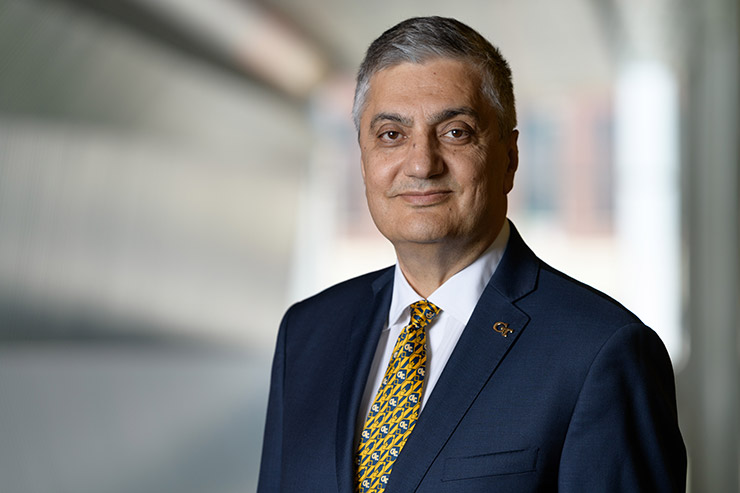
Research Enterprise Restructured
Under the new structure, the following positions have direct reporting lines to Abdallah:
- Senior vice president and director of Georgia Tech Research Institute
- Vice president of the Enterprise Innovation Institute
- Vice president for Research Operations
- Vice president for Research and director of Georgia Tech Research Corporation and Georgia Tech Applied Research Corporation
- Associate vice president for Research Computing Vice president for Interdisciplinary Research
A Georgia Tech graduate with master’s and doctoral degrees in electrical engineering, husband to a Tech industrial engineering graduate, and father of two current Tech students, Chaouki T. Abdallah is a Yellow Jacket through and through. And the unique perspective that these multidimensional touch points has afforded him in his new role as executive vice president for Research (EVPR) have enabled him to position the research enterprise “to sustain growth, exploit efficiencies where they may exist, and maximize the critical research impact of faculty, staff, and students.”
Abdallah announced an organizational restructure in March to provide improved service support for Tech’s entire research operation through increased collaboration and resource sharing, as well as a coordinated approach designed to strengthen the administrative ties between the research and academic divisions.
The restructure followed an in-depth assessment by Abdallah that involved several components including a review of the Comprehensive Administrative Review (CAR) report and preliminary CAR Working Group recommendations, and examination of various studies of the EVPR office, Interdisciplinary Research Institutes, the Office of Sponsored Programs, and entrepreneurial activities assessments provided by Tech and outside analysts. Abdallah also reviewed the structure and function of research offices at peer institutions.
“In conjunction with the objectives of the Comprehensive Administrative Review, and building on the many strengths that exist in our current personnel and processes, I believe we have established a new structure with an eye toward better service,” Abdallah said.
Additionally, Abdallah oversees the Industry Partnerships portfolio, a new structure combining all current activities related to Tech’s industry relationships. And Jennifer Herazy is now chief administrative officer for Academics and Research, reporting jointly to the provost and EVPR.
“These changes will strengthen our current administrative practices and build closely coordinated and streamlined services, reduce duplication of efforts, and increase overall operational efficiency,” said Rafael L. Bras, provost and executive vice president for Academic Affairs and K. Harrison Brown Family Chair.
HEAL Coming to Ivan Allen College Thanks to $3.3 Million Research Partnership
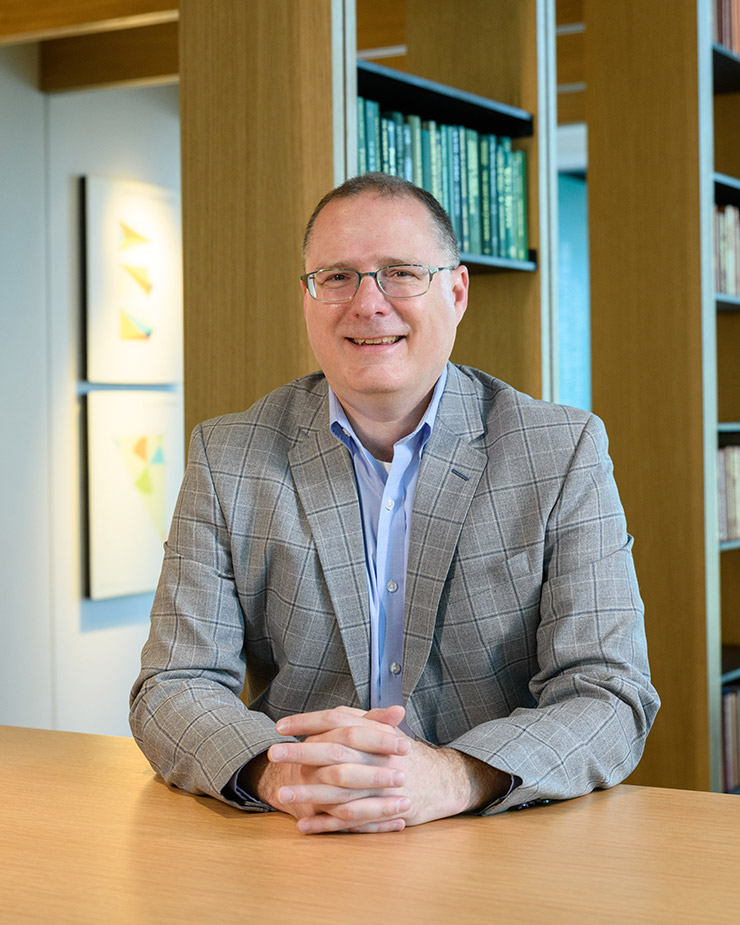
HEAL Coming to Ivan Allen College Thanks to $3.3 Million Research Partnership
In 2018, Tech and the American College of Radiology’s Neiman Institute announced a five-year, $3.3 million research partnership to establish the Health Economics and Analytics Lab (HEAL) within the Ivan Allen College of Liberal Arts.
HEAL focuses on applying big data analytics and artificial intelligence to large-scale medical claims databases — with a focus on medical imaging — to better ascertain how evolving health care delivery and payment models affect patients and providers.
“HEAL will provide research to inform the national medical imaging policy debate and develop new approaches for improving population health,” said Tech Professor of Economics and Executive Director of the Neiman Institute Danny R. Hughes, who leads the lab. “Drawing on Georgia Tech’s unparalleled strength in interdisciplinary research, HEAL is uniquely positioned to exploit the vast stores of medical data now available to ensure we move toward a sustainable health care system.”
HEAL supports full-time postdoctoral researchers, graduate research assistants, and affiliated Tech faculty to produce both method-ological and policy-oriented research. A secondary aim is to provide training and mentorship to radiologists interested in performing research in health economics and health policy.
In addition to financial support, the Neiman Institute provides HEAL researchers access to their extensive data resources, including large-scale medical claims databases covering millions of U.S. residents.
“This partnership provides a tremendous opportunity to leverage the Neiman Institute’s policy expertise with the analytical capabilities of a world-class engineering institution to address the pressing problems of improving population health, increasing access to medical care, and reducing medical costs.” said Geraldine McGinty, chair of the American College of Radiology’s Board of Chancellors.
Undergrad-Designed App Helps Fight Human Trafficking
An updated mobile application designed by undergraduates in the College of Computing for the human trafficking prevention organization Airline Ambassadors International (AAI) could drastically reduce human trafficking via airlines.
First developed in 2015, the TIP Line application received an update from students working in the CS Junior Design class, making reporting to authorities faster and more reliable by bringing trained users directly into contact with local law enforcement at the destination airport rather than depending on largely unreliable national hotlines. Instead of tipping off one of over 190 global national hotlines, many of which only function during local work hours and also suffer from a high rate of false reporting, TIP Line’s trained reporters are automatically connected with the correct authorities, many of whom have also taken a peer-to-peer training class with the airline personnel.
TIP Line challenges state-of-the-art techniques in reporting human trafficking by air because of its peer-to-peer and time-sensitive nature, as well as its capabilities in providing a data-rich format that allows video, photo, voice, and text to be anonymously transmitted to assigned law enforcement in real time.
The app allows a user to choose whom to contact with the information. A geo-location function can help determine which phone number is appropriate, or users can select a destination airport to find the best contact in the app’s database. If a different authority is required, users can scroll through a list of available numbers also stored in the database. Then, they are given the option to provide a description, video, audio, or photo as evidence to the local authority, providing additional information to discern the threat and how to apprehend the perpetrator and rescue the victim.
Currently, this version of the app is being used by over 7,000 trainees – airline flight crews, airport staffs, and others.
The TIP team, as the Tech students are affectionately called, aims to present the app to Interpol in hopes of further integrating it with enforcement agencies and, eventually, taking it beyond human trafficking.
Deep Learning Helps Robot Find Emotions
Deep Learning Helps Robot Find Emotions
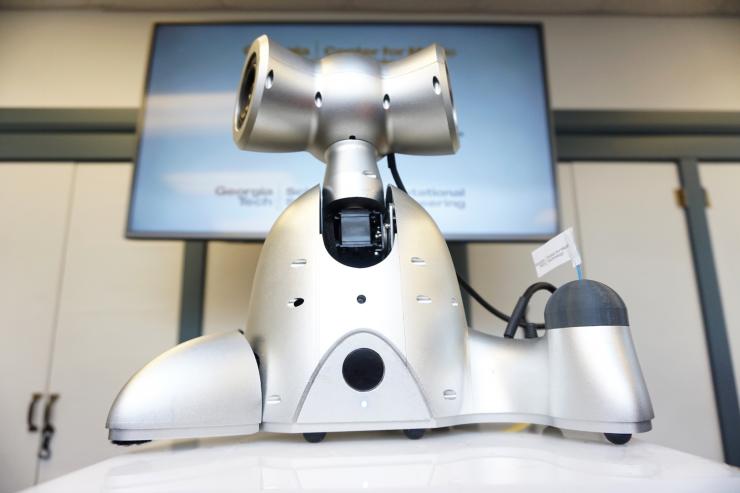
By combining music with deep learning, Tech researchers have demonstrated that communication simply needs empathy and a tune to take place.
“What we are most excited about is the ability to synthesize various attributes of music, language, and movement through deep learning, and project music as the core element of a robotic communication to show that our robots can understand and convey human emotion,” said Gil Weinberg, founding director of the College of Design’s Center for Music Technology, School of Music professor, and School of Interactive Computing adjunct professor.
Using deep learning analysis of music and language datasets, the team trained Shimi, a personal robot, to communicate emotions using non-linguistic channels. Shimi can now also analyze a person’s tone and speech in order to respond in an emotionally appropriate way. When Shimi debuted in 2012, it played songs from a user’s library, analyzed the music, and responded with corresponding gestures. But now, Shimi can learn emotional cues in people’s voices and respond with emotive voice and movement.
“By modeling humans’ affective communication cues, such as body gestures and vocal prosody, we’ve created a language focused on emotion. Society has seen countless efforts to recreate humanoid robots to interact with humans. Many of these robots fall prey to the same issue as their predecessors: the ‘uncanny valley.’ In the uncanny valley, robots simply become too close to human, without being human, which tends to lead to a sense of eeriness and revulsion. What then if a robot wasn’t trying to sound exactly like a human? What if we celebrated a robot for what it is, and for the things it can do that humans can’t?” Weinberg said.
Open Source Machine Learning Tool Could Help Choose Cancer Drugs
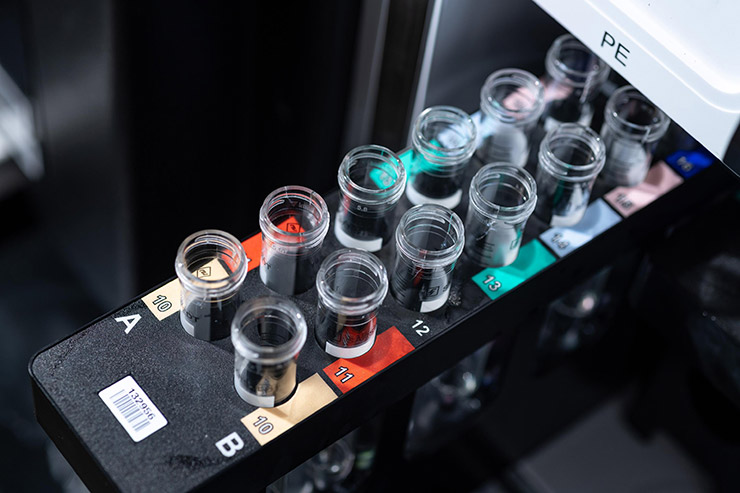
Sample tubes from sequencing equipment in Georgia Tech’s Petit Institute for Bioengineering and Bioscience.
Open Source Machine Learning Tool Could Help Choose Cancer Drugs
The selection of a first-line chemotherapy drug to treat many types of cancer is often a clear-cut decision governed by standard-of-care protocols, but what drug should be used next if the first one fails?
That’s where Georgia Tech researchers believe their new open source decision support tool could come in. Using machine learning, the open source tool could help clinicians choose the chemotherapy drug most likely to attack the disease in individual patients.
“By looking at RNA expression in tumors, we believe we can predict with high accuracy which patients are likely to respond to a particular drug,” said John McDonald, a professor in the School of Biological Sciences and director of its Integrated Cancer Research Center. “This information could be used, along with other factors, to support the decisions clinicians must make regarding chemotherapy treatment.”
The research, which could add another component to precision medicine for cancer treatment, was reported in the journal Scientific Reports. The work was supported in part by the Atlanta-based Ovarian Cancer Institute, the Georgia Research Alliance, and a National Institutes of Health fellowship.
The system will be made available as open source software, and McDonald’s team hopes hospitals and cancer centers will try it out. Ultimately, the tool’s accuracy should improve as more patient data is analyzed by the algorithm. He and his collaborators believe the open source approach offers the best path to moving the algorithm into clinical use.
“To really get this into clinical practice, we think we’ve got to open it up so that other people can try it, modify if they want to, and demonstrate its value in real-world situations,” McDonald said. “We are trying to create a different paradigm for cancer therapy using the kind of open source strategy used in internet technology.”
Open source coding allows many experts across multiple fields to review the software, identify faults, and recommend improvements, said Fredrik Vannberg, an assistant professor in the School of Biological Sciences. “Most importantly, that means the software is no longer a black box where you can’t see inside. The code is openly shared for anybody to improve and check for potential issues.”
Vannberg envisions using the decision-support tool to create “virtual tumor boards” that would bring together broad expertise to examine RNA data from patients worldwide.
“The hope would be to provide this kind of analysis for any new cancer patient who has this kind of RNA analysis done,” he added. “We could have a consensus of dozens of the smartest people in oncology and make them available for each patient’s unique situation.”
(text and background only visible when logged in)
